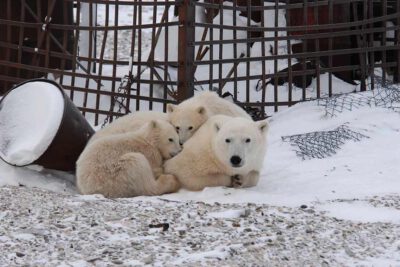
Scientific Study Combines 60 Years of Anecdotal Evidence; Findings Offer a Tool for Protecting Polar Bears and People, Calling for Immediate Action
Bozeman, Montana – A team of scientists from leading universities and organizations, including two from Polar Bears International, are behind the first-ever analysis of the impact of human-produced waste and food on polar bears. Published today in the journal Oryx, the study “Anthropogenic food: An emerging threat to polar bear conservation” combines case studies from across the Arctic into a singular report for wildlife management and northern communities to consider. Human and polar bear interaction and conflict are anticipated to rise as more polar bears spend more time onshore due to melting sea ice, emphasizing the need for proactive action to improve waste management and reduce food attractants. To learn more, access the full report here: https://doi.org/10.1017/S0030605322000278
While the correlation between black and brown bears and human food waste is well-studied, there has never been a review examining the implications of food waste and polar bears broadly. This hasn't historically been a problem in the North but is becoming one as the Arctic continues to warm, forcing more polar bears to spend more time onshore in more places. The knowledge is crucial for northern communities to coexist safely with polar bears. The report pulls anecdotal insights from case studies in Churchill, Manitoba, Canada; Arviat, Nunavut, Canada; First Nations coastal communities in Ontario, Canada; Kaktovik, Alaska, USA; Belushya Guba, Novaya Zemlya, Russia; Ryrkaypiy, Chukotka, Russia; and Svalbard, Norway.
Highlights from the report include:
- Issues:
- Increasing bear-human interaction: diminishing sea ice due to global warming is forcing polar bears to stay on land longer, fasting for longer periods of time. There is also increasing human activity in the North. With hungrier bears and more people, human-bear conflict is on the rise–which often leads to harm of at least one of the species.
- Human food availability: increasing human activity in the North is accompanied by more food and waste, which can attract hungry bears and become a flashpoint for human-bear conflict.
- Health issues for polar bears: when feeding on human food waste, the bears often ingest plastics, toxins, and may be more exposed to disease.
- Recommendations:
- Increasing risk calls for swift action: unless anthropogenic food sources are secured, including waste, threats to human safety and the viability of some polar bear subpopulations will continue.
- Proactive solutions are necessary: problems can become chronic, as bears will remember where they found food and continue to return over time. Once bears are conditioned to a food source, the problem is harder to manage, and more dangerous for everyone involved.
- Left unaddressed, situations can worsen rapidly: changes in the level of polar bear use of anthropogenic foods can occur rapidly, as seen in cases like the invasion of 52 polar bears in Belushya Guba, Russia; the bears were drawn to an open dump, with some entering the village proper.
- Tactical approaches: waste management solutions will be unique to each region and community, but may include both hard and electric fencing, incineration, cap and fill where feasible, landfill monitoring, bear-resistant waste cans, and increased access to deterrence and hazing tools/training.
Polar Bears International
polarbearsinternational.org










